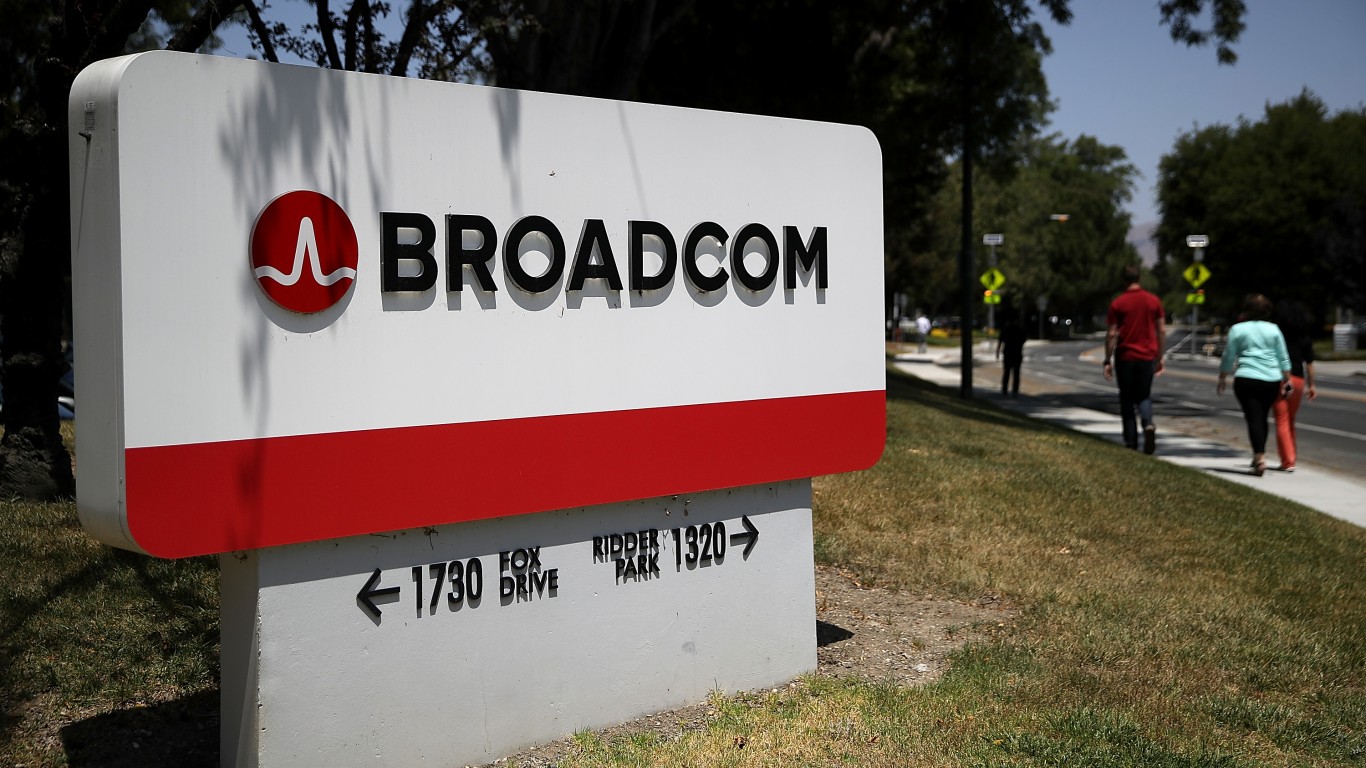
Broadcom (NASDAQ:AVGO) just became the next trillion-dollar stock, only the 10th company with such a large valuation. Its stock rocketed 21% higher in morning trading Friday after beating Wall Street’s fiscal fourth-quarter earnings forecasts the day before.
Demand for its artificial intelligence chips is far exceeding that for the rest of its business, with AI sales surging 220% in 2024. In the coming fiscal first quarter, Broadcom expects fiscal first-quarter sales of AI chips to jump 65% to $3.8 billion. That growth will spawn adjusted EBITDA margins of 66%.
24/7 Wall St. Key Points:
- Broadcom wowed the market with the strength of its AI business growth and forecasts for future expansion.
- With its data center business already white hot and Broadcom signing up to additional hyperscalers, the chipmaker has gale force winds pushing it forward.
- That could push its stock price higher, justifying another split, but investors should remain focused on AVGO’s execution of its business plan and not its stock price.
- If you’re looking for some stocks with huge potential, make sure to grab a free copy of our brand-new “The Next NVIDIA” report. It features a software stock we’re confident has 10X potential.
The results and outlook for next year caused AVGO stock to spike sending it close to $220 a share at this writing. With the sort of long-term growth Broadcom is predicting, there is good reason to suspect the semiconductor stock will see significant capital appreciation that could and likely will trigger another stock split.
Although Broadcom just divided its shares 10-for-1 in July, taking them from $1,700 a stub down to $170, there is another looming just over the horizon.
A stock is more than just its price

A stock split changes nothing about a company, but a market often views them favorably. They send a signal that management believes additional growth and profits are coming. And by dicing up the stock into smaller slices, a split makes the stock available to more investors.
Yet investors should never buy a stock simply based on whether it has or may split. Over the long haul, the value of a stock is determined by its business that generates earnings, not its price.
If you look at Broadcom’s stock, it looks expensive. Shares go for 191 times trailing earnings, 29 times next year’s estimates, and 22 times sales. Those are nosebleed valuations that traditionally argue for using caution before buying in. However, price doesn’t tell you the whole story.
AI is generating hurricane-force tailwinds

Broadcom was previously best known as one of the the premier provider of mobile device chipsets, primarily to Apple (NASDAQ:AAPL), which recently accounted for 20% of total revenue.
Although smartphone chips still represent a significant portion of the Broadcom’s business, the chipmaker made a conscious decision to focus more on data center infrastructure, such as Ethernet switching and routing silicon. That’s where its AI chips are now clustered.
Hyperscalers are driving sales of Broadcom’s custom AI accelerators and merchant networking chips. In its earnings conference call, president and CEO Hock Tan noted that its three hyperscale customers (hyperscalers are essentially large-scale data centers) received twice as many of the chipmaker’s AI XPUs, or cross-architecture computing solutions spanning all major chip types.
Broadcom said its AI networking revenue, which represented 76% of all its networking business, grew 158% year-over-year. It predicts the addressable market for AI components that it designs for these data center operators would reach as high as $90 billion by fiscal 2027.
Last year, Broadcom said AI chips represented 15% of total revenue and in the third quarter it forecast they would amount to 35%. However, they reached 41% of all sales at the end of the year. Even the chip stock can’t keep up with how fast demand is growing and it just won two new hyperscale customers in the fourth quarter.
Another stock split on the horizon?
To bring it back to Broadcom’s stock price, valuation, and when it might split its stock again, although the semiconductor maker looks pricey, its business is growing into its valuation. As sales gain and profit margins widen, its valuation will improve even as the stock price increases.
The July stock split was its first since Broadcom was acquired by Avago Technologies in 2016 (Avago chose to keep the Broadcom name afterward). However, the chipmaker had previously split its shares three times before then, the last being in 2006.
I don’t think Broadcom needs to hit a four-digit price target before it splits its shares again. That would be about a fivefold increase in its valuation and we won’t need a $5 trillion market cap before we get a split.
With earnings expected to grow at 20% a year (though I think Wall Street’s estimates are low), we could see AVGO double in value sometime within the next four years. That kind of valuation and price could make it advantageous to cut the share price again. And if it grows faster, as I believe it will, I’d expect to see a stock split closer to 2028 than later.
Thank you for reading! Have some feedback for us?
Contact the 24/7 Wall St. editorial team.



